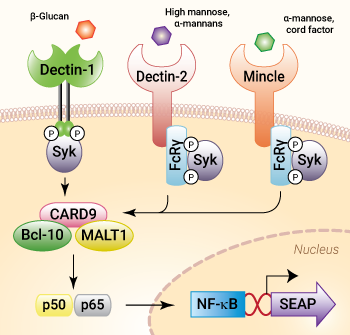HEK293 CLR Reporter Cells
InvivoGen provides a collection of HEK293-derived CLR (C-type lectin receptor) Reporter cells

Signaling in HEK-Blue™ CLR cells
(click to enlarge and see legend)
HEK-Blue™ CLR cells are engineered HEK293 cell lines designed to provide a rapid, sensitive, and reliable method to screen and validate Dectin and Mincle agonists or antagonists. Dectin and Mincle are members of the large C-type Lectin receptors (CLRs) family of receptors that bind to carbohydrates in a calcium-dependent manner. These receptors are involved in fungal recognition and the modulation of the innate immune response.
Our HEK-Blue™ CLR cells stably express human Dectin-1, human Dectin-1b, mouse Dectin-1b, mouse Dectin-2, or mouse Mincle. These cells also feature an NF-κB-inducible SEAP (secreted embryonic alkaline phosphatase) reporter gene. The activity of SEAP can be easily monitored in the cell supernatant using the SEAP detection reagents, QUANTI-Blue™ or HEK-Blue™ Detection.
InvivoGen's cell lines are extensively tested for viability, stability, biological activity, and absence of mycoplasma to ensure strong and reproducible results. Moreover, we provide detailed handling and experimental procedures for all cell lines, to minimize the end-user's need for optimization or troubleshooting.
InvivoGen also offers a murine macrophage-derived CLR reporter cell line that endogenously expresses Dection and Mincle.
Background
Dectin-1 plays an important role in antifungal innate immunity. Upon binding to its ligand, Dectin-1 triggers phagocytosis and signaling through the kinase Syk and the adaptors CARD9-Bcl10-Malt1 leading to the production of reactive oxygen species (ROS), the activation of NF-κB and the subsequent production of pro-inflammatory cytokines. Dectin-1 signaling has been shown to collaborate with Toll-like receptor 2 (TLR2) signaling to enhance the responses triggered by each receptor.
Dectin-2 also plays an important role in antifungal innate immunity. This receptor binds to mannose carbohydrates, such as the mannose-capped lipoarabinomannan of mycobacteria and α-mannans found in Candida albicans. Upon binding to its ligand, Dectin-2 couples with the Fc receptor gamma chain and signals through the kinase Syk and the adaptors CARD9/Bcl-10/MALT1, triggering the activation of NF-κB and the subsequent production of pro-inflammatory cytokines.
Mincle is a multi-task danger receptor that recognizes various ligands such as damaged cells, fungi, yeast, and mycobacteria. It detects trehalose-6,6-dibehenate (TDB) and heat-killed M. tuberculosis (HKMT).




